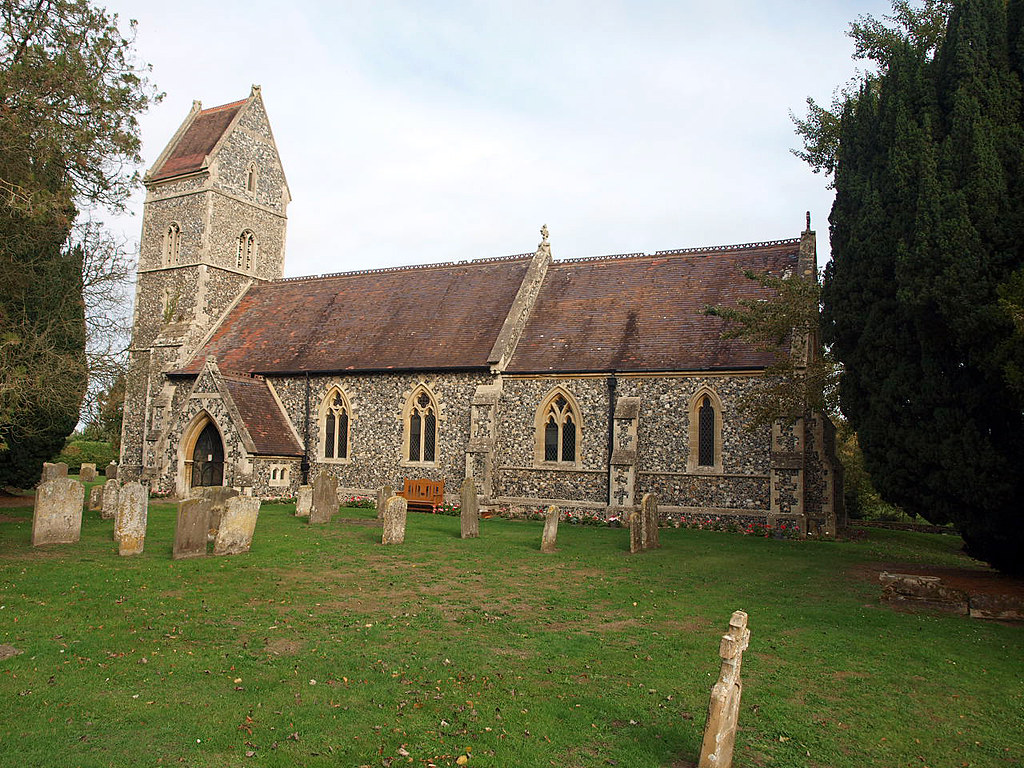As a meaningless aside there was a constant background woodpecker type noise - it took me a while to realise that it was army training firing of weapons.
ST ETHELBERT, East Wretham. 1865. W tower with saddleback roof, nave and chancel. In the nave re-used Norman S doorway with one order of shafts and zigzag both on the wall and at r. angles to it. - STAINED GLASS. St Margaret by Wooldridge, made by Powell & Sons, 1874. - PLATE. Chalice, unmarked.
EAST WRETHAM. We may come to it by a lovely five miles of heath and fir woods from Croxton, finding first the little flint church in a charming corner on the edge of a great park. Between it and the rest of the village is an old windmill on high ground by a row of Scots pines. There are several lakes in the neighbourhood, and on one being drained last century the remains of an old lake-dwelling were found.
Compared with this memory of the Stone Age the fine Norman doorway of the church, enriched with zigzag and nail-head and carved capitals, is very young, but it is the most ancient thing we find in this 14th-century shrine. The church is lovingly tended, and is a study of white and blue in its walls and furnishings, charmingly lit by candles on iron standards, like little trees among the dark pews. Two lines of them on each side of the chancel make a pretty avenue of light to the sanctuary, where brass candelabra hang by the altar, which is guarded by four golden angels, each holding a candle. With the fine candelabra in the chapel we counted over a hundred candles here.
The canopied oak reredos has oil paintings of Christ Risen, Mary, and Gabriel. On the walls of the sanctuary are paintings of angels. The modern font has a fine cover painted in medieval colours, shaped like a tall spire, crowned by a pelican and her young; and round it, under eight canopies, stand St Michael slaying the dragon, Elizabeth with flowers, St George in armour with shield, Philip with a scroll, St Cecilia with her organ, St James with a book, St Gereon in black and gold armour with a blue mantle, and St Agnes with a lamb. There is a Flanders cross on the nave wall, and on the green space by the church gate is a cross to 14 men who did not come back.
There lies in this churchyard a man of great courage and brainpower who served his generation well and deserves the gratitude of posterity, for he was an inventor and a pioneer, Sir John Dewrance. He was an engineer, and won a gold medal early in his working life by a paper on the corrosion of marine boilers, and before his work was done he had taken out over a hundred patents for engineering inventions. A man of far-reaching ideas, he saw the possibilities of Kent coal long before most men and risked his reputation and his fortune in seeking Kent coal when the scheme seemed nothing but a costly dream, and coal-shafts nothing but holes to pour money down. He was chairman of the original companies for the development of the Kent coalfield and it is gratifying that he lived to see them bringing thousands of tons of coal to the surface. He married a granddaughter of Richard Trevithick, and it must have been a source of satisfaction to him that Kent, which gave Sir John himself a great reward, also gave Trevithick a little hope in his last days and a free man’s grave to lie in.
Flickr.
Flickr.

No comments:
Post a Comment